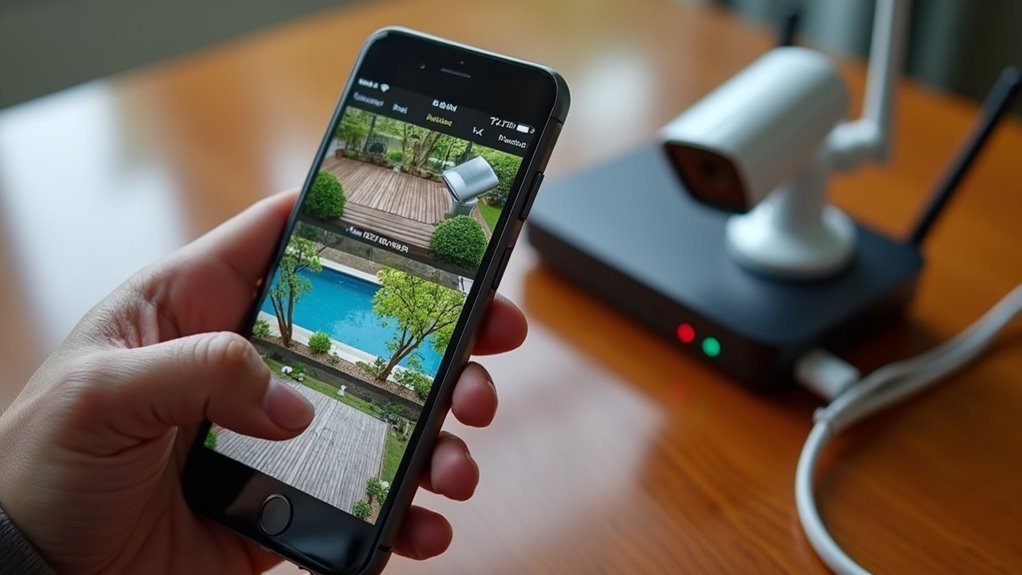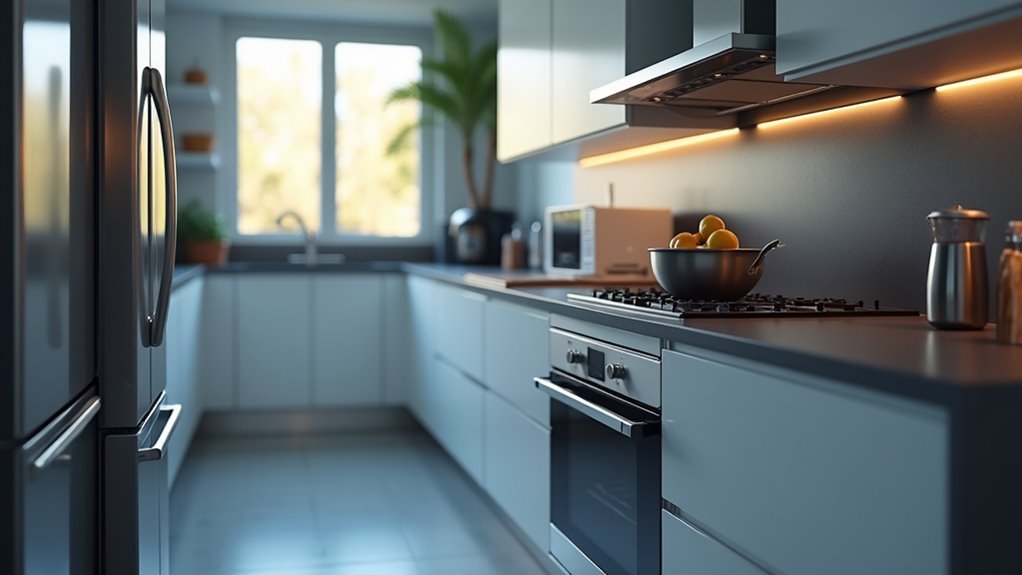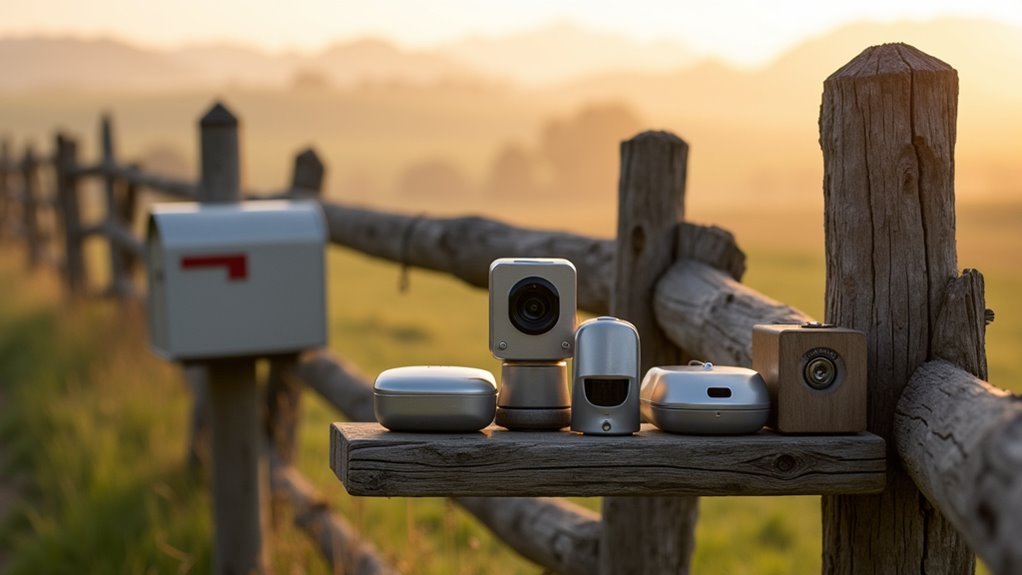You’ve probably stared at multiple smart home apps on your phone, switching between different platforms just to control your lights, thermostat, and security system. This fragmented approach isn’t just inconvenient—it’s limiting your home’s potential. The right dashboard tool can unify everything into a single, powerful interface that responds exactly how you want it to. But choosing between Home Assistant’s complexity, SharpTools’ simplicity, or OpenHAB’s advanced features requires understanding what each platform actually delivers.
Home Assistant Dashboard Features and Capabilities

When you’re looking to centralize control of your smart home devices, Home Assistant’s dashboard stands out as one of the most versatile solutions available.
Unlike many smart home platforms that limit your customization options, you’ll find Home Assistant offers fully customizable dashboards with intuitive drag-and-drop functionality for effortless organization.
You can integrate thousands of devices and brands into a single unified interface, giving you real-time monitoring and control capabilities.
The platform’s powerful automation engine lets you create sophisticated routines using either YAML files or a visual editor.
You’ll appreciate the remote access feature that works on any device while keeping your data stored locally for privacy.
The built-in “Assist” voice assistant enables natural language control directly from your home automation dashboard.
SharpTools for Unified Smart Home Control
While Home Assistant excels at extensive customization, SharpTools takes a different approach by focusing on streamlined simplicity and cross-platform compatibility.
You’ll access your entire smart home through a web-based interface that works on any device, providing real-time monitoring and control capabilities.
The platform’s drag-and-drop dashboard builder lets you create personalized layouts with tiles displaying device statuses and quick action buttons.
You’ll connect seamlessly with popular smart home platforms like SmartThings and Hubitat, controlling a wide range of devices including lights, locks, and sensors from one unified interface.
Smart automation management becomes effortless as you can run routines directly from the dashboard with simple taps.
Security features include PIN protection for sensitive controls while maintaining view-only access for monitoring.
OpenHAB Advanced Customization Options

You’ll find OpenHAB’s rules engine scripting capabilities let you create sophisticated automations that respond to complex conditions and trigger multiple actions across your entire smart home ecosystem.
The platform’s UI configuration flexibility means you can design completely custom interfaces using HABPanel or Basic UI, tailoring every widget and layout to match your specific needs.
Whether you’re building simple toggles or complex dashboards with real-time data visualization, OpenHAB’s modular architecture guarantees you can expand functionality without sacrificing performance.
Rules Engine Scripting
OpenHAB’s rules engine transforms your smart home from a collection of connected devices into an intelligent, responsive ecosystem.
You’ll create sophisticated automations using DSL or JavaScript, crafting custom logic that responds to device state changes, time schedules, and external events. The rules engine scripting capabilities let you implement complex scenarios like optimizing energy usage based on occupancy patterns or electricity rates.
You can build timers, calculations, and conditional statements that work together seamlessly. The real-time testing and debugging features through OpenHAB’s web interface help you refine your scripts efficiently.
Since everything runs with local control, your automations remain functional even without internet connectivity. You’ll also integrate external APIs and third-party services, expanding your automation possibilities beyond traditional smart home devices.
UI Configuration Flexibility
Beyond scripting powerful automations, OpenHAB empowers you to craft interfaces that match your exact workflow and aesthetic preferences. The platform’s extensive ui customization options let you design personalized dashboards that reflect your specific requirements.
You can choose between Paper UI for straightforward configuration or HABPanel for sophisticated interface development.
OpenHAB’s modular architecture supports various front-end technologies, enabling you to create unique visualizations and control layouts. Whether you’re a beginner or among advanced users with coding expertise, you’ll find appropriate tools for your skill level.
The system accommodates different user interfaces ranging from simple controls to complex dashboard arrangements.
Comprehensive documentation and active community support provide guidance for exploring advanced customization techniques, ensuring you maximize your OpenHAB setup’s potential.
Node-RED Visual Automation Workflows
You’ll discover that Node-RED transforms home automation through its intuitive drag-and-drop interface, where you create complex workflows by connecting visual nodes instead of writing traditional code.
The platform’s strength lies in its ability to seamlessly integrate diverse devices, APIs, and services into unified automation sequences that respond to your specific needs.
You can build sophisticated logic chains that trigger multiple actions across different systems, creating truly intelligent automation scenarios that adapt to your daily routines.
Flow-Based Programming Essentials
When you’re ready to move beyond basic automation rules, Node-RED’s flow-based programming approach transforms how you’ll create and manage smart home workflows. This visual editor lets you drag nodes onto a canvas and connect them with wires, creating powerful automation sequences without traditional coding.
| Component | Function | Example |
|---|---|---|
| Input Nodes | Trigger flows | Motion sensors, time schedules |
| Processing Nodes | Transform data | Logic gates, filters |
| Output Nodes | Execute actions | Light controls, notifications |
Node-RED’s customizable nature means you’ll build reusable sub-flows for repeated tasks. The platform supports MQTT, HTTP, and WebSocket protocols, enabling seamless integration across devices. You can host it on Raspberry Pi or alongside existing hubs, making your automation setup incredibly flexible and scalable.
Device Integration Capabilities
Node-RED’s real strength emerges through its extensive device integration capabilities that connect virtually any smart home component into unified workflows.
You’ll find it supports a wide range of protocols including MQTT, Z-Wave, and Zigbee, enabling seamless communication across different manufacturers and technologies. Unlike Home Assistant’s configuration-heavy approach, Node-RED’s visual interface lets you drag and drop integration nodes directly into your automation flows.
You can monitor and control devices in real-time, receiving immediate feedback when statuses change.
The platform’s extensive library of pre-built nodes means you’re not limited to specific brands or protocols. Whether you’re connecting sensors, switches, or complex IoT devices, Node-RED’s device integration capabilities eliminate compatibility barriers that typically fragment smart home ecosystems.
Automation Logic Creation
While traditional automation platforms force you into rigid if-then scenarios, Node-RED’s browser-based flow editor transforms complex logic creation into an intuitive visual experience.
You’ll build sophisticated automation workflows by simply dragging and dropping nodes, then wiring them together to create custom logic that exceeds typical smart home platform capabilities.
The platform’s seamless MQTT integration enables real-time message passing between devices, making complex interactions effortless.
You can deploy Node-RED on your existing automation hub or a separate server, giving you complete flexibility in resource management.
What sets Node-RED apart is its community-driven ecosystem.
You’ll access a vast library of shared nodes and templates, allowing you to leverage existing workflows while contributing your own solutions to help other users.
Gladys Assistant Privacy-Focused Interface
Since privacy concerns continue to drive many homeowners away from cloud-based smart home platforms, Gladys Assistant offers a compelling alternative that keeps all your data local and secure. This privacy-focused solution runs entirely offline, ensuring your information never leaves your home network.
You’ll appreciate the intuitive scene editor that lets you create complex automation schedules without programming knowledge. The interface streamlines everything from basic device controls to advanced logic creation, while supporting live camera feeds and voice commands for thorough home management.
Gladys deploys easily via Docker on low-power hardware, making it accessible regardless of your technical expertise or budget. The platform delivers a polished out-of-the-box experience that minimizes complexity while maximizing your control over home automation.
Domoticz Lightweight Dashboard Solutions

For users seeking an even more resource-efficient approach, Domoticz delivers exceptional performance on minimal hardware while maintaining extensive smart home control capabilities.
This lightweight dashboard excels on older Raspberry Pi models where other platforms might struggle, making it perfect for budget-conscious installations.
You’ll appreciate Domoticz’s broad protocol support, including Z-Wave and MQTT, which enables seamless integration across diverse device ecosystems.
The minimalistic interface prioritizes essential controls and device statuses, ensuring you’re not overwhelmed by unnecessary clutter.
What sets this smart home platform apart is its customizable layout tools and powerful scripting options.
You can create tailored visualizations and implement advanced automation logic specific to your needs, transforming a simple lightweight dashboard into a sophisticated command center.
Iobroker Modular Dashboard Architecture
When you need maximum flexibility in your home automation setup, ioBroker’s modular architecture delivers unparalleled customization through its innovative adapter system. Each integration operates as a separate adapter, letting you build your smart home exactly how you want it.
| Feature | Protocol Support | Configuration |
|---|---|---|
| Adapters | MQTT, Zigbee, KNX | Modular system |
| Automation | Blockly no-code | Visual programming |
| Deployment | Cloud or local | Flexible setup |
| Performance | High-speed processing | Advanced optimization |
You’ll find ioBroker’s protocol compatibility exceptional, supporting everything from MQTT to KNX devices. The built-in Blockly tool makes automation creation straightforward without coding knowledge. While initial setup requires technical expertise, you’ll appreciate the speed and flexibility once configured. This modular architecture makes ioBroker perfect for advanced users seeking thorough smart home control.
Essential Dashboard Design Principles
When designing your home automation dashboard, you’ll need to establish a clear visual hierarchy that guides users naturally through the interface and highlights the most important controls.
Your layout should organize information logically, placing frequently used functions prominently while keeping secondary features accessible but unobtrusive.
You’ll also want to implement customizable tile organization that lets users arrange, resize, and configure dashboard elements according to their specific preferences and daily routines.
Visual Hierarchy and Layout
The foundation of any effective home automation dashboard lies in its visual hierarchy—the strategic arrangement of elements that guides your eye naturally from the most important information to supporting details.
You’ll want to leverage size, color, and contrast to highlight essential controls while keeping secondary options accessible but unobtrusive.
A consistent layout guarantees you’ll always find controls where you expect them. Place frequently used features like lighting and climate controls prominently, while organizing related items through grouping and proximity principles.
This approach makes navigation intuitive and reduces learning curves.
Responsive layouts are vital for seamless functionality across devices. Your dashboard should adapt flawlessly from tablets to smartphones, maintaining usability without sacrificing features.
Implement visually distinct tiles for different device categories—lighting, security, climate—enabling quick recognition and efficient interaction regardless of screen size.
Customizable Tile Organization
Building on these foundational layout principles, you’ll find that customizable tile organization transforms your dashboard from a static interface into a dynamic workspace that adapts to your specific needs.
You can drag and drop tiles to rearrange your dashboard according to your user preferences, optimizing the interface for both landscape and portrait orientations across different screen sizes.
Here’s how customizable tiles enhance your smart home environment:
- Personalized Layouts – Prioritize your most important devices and functions for quick access, improving usability and efficiency.
- Visual Customization – Modify tiles with unique icons, labels, colors, and styles for easier navigation.
- Security Features – Implement PIN protection for certain controls or enable view-only modes for flexible access.
This organization improves aesthetics while facilitating quicker decision-making and smoother automation management.
Multi-Device Responsive Interface Setup
Since modern households rely on multiple devices with varying screen sizes, configuring a multi-device responsive interface setup becomes crucial for effective smart home management.
You’ll need dashboard tools that automatically adapt to tablets, smartphones, and desktops while maintaining functionality across all platforms.
The best solutions offer customizable layouts with drag-and-drop functionality, letting you rearrange tiles and widgets based on your device’s screen size.
Whether you’re using your phone one-handed or controlling a wall-mounted tablet, landscape and portrait layout optimization guarantees comfortable interaction.
Remote access capabilities enable you to monitor and control your smart home from anywhere, providing convenience when you’re away.
This flexibility means you can adjust thermostats, lock doors, and manage multiple devices seamlessly, regardless of which device you’re using.
Battery Management and Device Monitoring
While your responsive interface guarantees seamless control across devices, maintaining peak performance of your smart home ecosystem depends heavily on effective battery management and device monitoring.
Most battery-powered devices require replacement every 10 days for ideal functionality, making proactive monitoring essential.
Modern dashboards excel at tracking battery status through visual indicators and real-time updates. You’ll receive alerts when power levels drop below critical thresholds, preventing unexpected device failures.
Key battery management features include:
- Color-coded status tiles – Green, yellow, and red indicators show battery levels above 30%, below 30%, and below 10%
- Automated alert systems – Push notifications warn you before devices go offline
- Comprehensive device tracking – Monitor all connected sensors and devices from one centralized location
This proactive approach guarantees your smart home operates reliably.
Network Configuration for Dashboard Performance
Beyond device monitoring, your dashboard’s responsiveness depends on a well-configured network infrastructure that prioritizes automation traffic.
Your home automation setup should primarily rely on Z-Wave or ZigBee protocols, which deliver reliable, low-latency communication between devices. You’ll want to minimize Wi-Fi usage, connecting only essential devices like speakers to reduce network congestion and interference.
During initial setup, you may need to upgrade to a higher-capacity router to handle the increased number of connected devices effectively. Proper network configuration involves separating your automation devices from PCs and other high-traffic equipment to manage network noise and maintain peak performance.
Regular monitoring of your network’s performance helps identify potential issues before they impact your dashboard’s functionality, ensuring seamless operation of your smart home system.
Creating Custom Tiles and Visual Elements
Once you’ve established a robust network foundation, you’ll want to focus on creating custom tiles and visual elements that transform your dashboard into an intuitive control center.
Modern platforms offer extensive personalization capabilities that let you design interfaces matching your specific needs and preferences.
Key customization features include:
- Customizable tiles – Adjust icons, labels, colors, and styles while displaying real-time device status like temperature readings or security alerts for immediate visibility.
- Drag-and-drop functionality – Easily arrange tiles and widgets to create ideal layouts that adapt to different screen sizes and orientations, supporting both landscape and portrait views.
- Advanced customization options – Implement PIN protection for specific controls, enhancing security while maintaining convenient access to frequently used features and critical system information.
Integration With Popular Smart Home Platforms
When you’re building a home automation dashboard, you’ll need to make certain it works seamlessly with your existing smart home ecosystem.
Most dashboard tools offer built-in compatibility with popular hubs like SmartThings, Hubitat, and Home Assistant, letting you pull all your devices into one unified interface.
You’ll also want to take into account how well your chosen dashboard communicates across different protocols like Zigbee, Z-Wave, and MQTT to maximize device integration possibilities.
Platform Compatibility Overview
Since most smart homes include devices from multiple manufacturers and protocols, choosing a dashboard tool with broad platform compatibility becomes essential for creating a unified control experience.
When evaluating compatibility, you’ll find that leading dashboard tools support extensive device ecosystems through various integration methods.
The top compatibility features you should consider include:
- Native protocol support – Tools like Home Assistant and OpenHAB connect directly with thousands of devices across multiple communication standards.
- Platform bridges – SmartThings and Hubitat integration allows seamless device management from existing hubs.
- Privacy-focused options – Gladys Assistant operates offline while maintaining broad device compatibility for security-conscious users.
These dashboard tools enable real-time monitoring and control across platforms, providing unified interfaces for live feeds, scheduling, and automation management.
Cross-Platform Communication Protocols
Modern dashboard tools achieve their universal device compatibility through sophisticated cross-platform communication protocols that serve as the backbone of integrated smart home systems. You’ll find that platforms like SmartThings, Hubitat, and Home Assistant leverage protocols such as Zigbee, Z-Wave, and MQTT to enable seamless communication between devices from different manufacturers.
| Protocol | Range | Power Usage | Device Types | Network Type |
|---|---|---|---|---|
| Zigbee | 10-20m | Low | Sensors, lights, locks | Mesh |
| Z-Wave | 30m | Ultra-low | Switches, thermostats | Mesh |
| MQTT | WiFi range | Variable | All IP devices | Star/Hub |
| WiFi | 50m+ | High | Cameras, speakers | Star |
| Bluetooth | 10m | Low | Wearables, beacons | Point-to-point |
This cross-platform compatibility transforms your smart home devices into a cohesive ecosystem, enabling centralized control through unified dashboards that you can customize for peak functionality.
Optimizing Dashboard Performance and Speed
Three critical factors determine whether your home automation dashboard delivers lightning-fast performance or frustrates you with sluggish responses: interface architecture, network optimization, and computational efficiency.
1. Web-Based Interface Design – You’ll want a responsive web interface that’s well suited for all your devices.
I’ve used drag-and-drop layouts to prioritize frequently accessed controls, and customizable tiles help you quickly assess device statuses without endless scrolling.
2. Network Management – Separate your automation devices from general Wi-Fi traffic.
This prevents network congestion and guarantees faster communication between smart devices.
3. Lightweight Processing – I’m using streamlined automation platforms like Node-RED or DOMOTICZ because they reduce computational overhead.
These tools handle complex logic efficiently while maintaining snappy response times across your dashboard.
Frequently Asked Questions
What Is the Best Home Automation Software?
You’ll find Home Assistant’s your best choice for extensive device support and privacy. It’s beginner-friendly yet powerful, supporting over 1,000 brands while keeping everything local and secure.
Which Brand Is Best for Home Automation?
You’ll find Home Assistant’s the top choice if you prioritize privacy and extensive integrations. However, if you’re new to automation, SmartThings offers easier setup, while Hubitat excels for advanced users.
What Is the #1 Product That Users Wish to Control With Home Automation?
You’ll find lighting systems top users’ automation wish lists. You’re drawn to controlling lights for convenience and energy savings, making smart lighting the most desired home automation feature across households seeking smarter living solutions.
What Is the Best Home Automation Hub?
You’ll find Home Assistant stands out as the top choice if you’re tech-savvy, offering unmatched customization and device compatibility. For beginners, SmartThings provides excellent ease-of-use while maintaining broad smart device support.





Leave a Reply